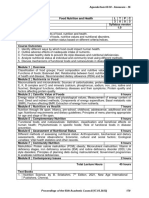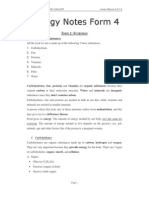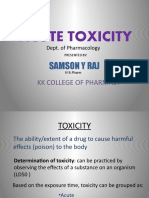BFT - 604
BFT - 604
Uploaded by
Swara BhaydeCopyright:
Available Formats
BFT - 604
BFT - 604
Uploaded by
Swara BhaydeCopyright
Available Formats
Share this document
Did you find this document useful?
Is this content inappropriate?
Copyright:
Available Formats
BFT - 604
BFT - 604
Uploaded by
Swara BhaydeCopyright:
Available Formats
BFT604: Nutraceuticals and Functional Foods 45
LEARNING OBJECTIVES
1. To learn about the various nutraceutical molecules and their application in functional food
2. To comprehend the beneficial effect of pre and probiotics and understand the concept of nutrigenomics
3. To understand the nutritional value of food
LEARNING OUTCOME
1. The ability to understand the functionality of bioactives
2. To be able to use pre and probiotics for health food products
3. The ability to formulate nutraceutical products
UNIT I: Introduction to Nutraceuticals 10
Introduction to Nutraceuticals: history, definition, different schemes of classification;
Essential nutrients, their classification and functions, Perceived effect of diet on disease
prevention; Nutraceuticals as therapeutic agents; Functional foods: definition, difference
between nutraceuticals and functional foods, list of functional foods and their benefits; Indian
scenario and market potential of nutraceuticals.
UNIT II: Phytochemicals and Zoochemicals 12
Phytochemicals: classification of different secondary metabolites from plants; Their food
sources, structural formula, biochemical nature, mode of action and role in curing different
diseases; phytoestrogens, flavonoids, phenols, tannins, saponins, lignans, carotenoids; Zoo
chemicals: Omega -3 fatty acids, lutein, CLA: Food sources, typical properties, structural
formula, functions in disease control; Overview of different commercially available
phytochemicals and zoochemicals.
UNIT III: Probiotics and Prebiotics as Nutraceuticals 12
Definition, classification – Type of classification (Probiotics, probiotics and synbiotics:
Taxonomy and important features of probiotic microorganisms. Health effects of probiotics
including mechanism of action. Probiotics in various foods: fermented milk products, non-
milk products etc. Prebiotics: Definition, chemistry, sources, metabolism; synbiotics:
functions and examples; Effect of processing, physiological effects, perspective applications
for designing commercial products; currently available products in market.
UNIT IV: Product development, assessment and Regulations of Nutraceuticals 11
Development of nutraceutical products; Bioavailability of different nutraceuticals, In vitro and In
vivo methods for the assessment of bioavailibility, Factors affecting bioavailability,
Qualitative and quantitative methods for assessment of nutraceuticals: important
chromatographic techniques: HPLC; GC; Gel Electrophoresis etc, Validation of assessment
assay; Health Claims, regulations and safety issues- International and national.
References:
1. Aluko, Rotimi, Functional Foods and Nutraceuticals, Springer-Verlag New York Inc.,2012.
2. Satinder Kaur Brar, Surinder Kaur and Gurpreet Singh Dhillon, Nutraceuticals Functional Foods, 2014.
3. Robert E.C. Wildman, Robert, Wildman, Taylor C, Handbook of Nutraceuticals and Functional Foods, Third
Edition, Wallace,2002.
2019 Onwards
You might also like
- Handbook of Surfactants - PORTER - 2nd EdDocument4 pagesHandbook of Surfactants - PORTER - 2nd EdJulieta0% (3)
- Hydro X Boiler TreatmentDocument5 pagesHydro X Boiler TreatmentZoran ObradovicNo ratings yet
- Sachin Kumar - - School Project Report on Nutraceutical (1)Document26 pagesSachin Kumar - - School Project Report on Nutraceutical (1)sachinkryadav907No ratings yet
- MRA204TDocument2 pagesMRA204TMy PhotosNo ratings yet
- Dr. V K BatishDocument45 pagesDr. V K Batishjbabu123No ratings yet
- Probiotics PharmAspireDocument11 pagesProbiotics PharmAspirePratik Sanjay ShindeNo ratings yet
- PHM657 Nutraceuticals and Functional Foods Course ObjectivesDocument1 pagePHM657 Nutraceuticals and Functional Foods Course ObjectivesSaima HaroonNo ratings yet
- Course Content For Food Biotechnology and Food Safety and LegislationDocument4 pagesCourse Content For Food Biotechnology and Food Safety and LegislationHenriettah NakisoziNo ratings yet
- Probiotics in Functional Foods: © 2019 Elsevier Inc. All Rights ReservedDocument17 pagesProbiotics in Functional Foods: © 2019 Elsevier Inc. All Rights ReservedRominaNo ratings yet
- Abdul Faheem Project on NutraceuticalDocument26 pagesAbdul Faheem Project on NutraceuticalAbdul FaheemNo ratings yet
- How Do We Know When Something Called "Probiotic" Is Really A Probiotic - A Guideline For Consumers and Health Care ProfessionalsDocument10 pagesHow Do We Know When Something Called "Probiotic" Is Really A Probiotic - A Guideline For Consumers and Health Care ProfessionalsDhayu Mart Hindrasyah PandiaNo ratings yet
- Role of Nutraceuticals in Health Promotion: Swati Chaturvedi, P. K. Sharma, Vipin Kumar Garg, Mayank BansalDocument7 pagesRole of Nutraceuticals in Health Promotion: Swati Chaturvedi, P. K. Sharma, Vipin Kumar Garg, Mayank BansalFree Escort ServiceNo ratings yet
- Postbiotics-Parabiotics The New Horizons in Microbial Biotherapy and Functional FoodsDocument22 pagesPostbiotics-Parabiotics The New Horizons in Microbial Biotherapy and Functional FoodsLevente BalázsNo ratings yet
- Nutraceuticals PSDocument30 pagesNutraceuticals PSpranjalsharma1912100% (1)
- 000-7intro24524 IntroDocument2 pages000-7intro24524 IntroJavier HernandezNo ratings yet
- MRA 204T IntitalDocument5 pagesMRA 204T IntitalparasriramdcaNo ratings yet
- NUTRACEUTICALDocument8 pagesNUTRACEUTICALMukesh TiwariNo ratings yet
- Food Safety Officer Syllabus PSCDocument2 pagesFood Safety Officer Syllabus PSCA Rahman100% (1)
- ProbioticsDocument44 pagesProbioticsSATISH SINGHNo ratings yet
- FF OverviewDocument10 pagesFF OverviewrenNo ratings yet
- 88 - Indian Nutraceutical Market Opportunities - Report - LRDocument44 pages88 - Indian Nutraceutical Market Opportunities - Report - LRdhananjayNo ratings yet
- Overview of NutraceuticalsDocument8 pagesOverview of Nutraceuticalsmaria dulceNo ratings yet
- Tbit204l - Food-Nutrition-And-Health - TH - 1.0 - 70 - Tbit204l - 65 AcpDocument2 pagesTbit204l - Food-Nutrition-And-Health - TH - 1.0 - 70 - Tbit204l - 65 AcpKarthikeyan SivashanmugamNo ratings yet
- Health Bene Ts of Probiotics: A Review: Maria Kechagia, Dimitrios Basoulis, (... ), and Eleni Maria FakiriDocument8 pagesHealth Bene Ts of Probiotics: A Review: Maria Kechagia, Dimitrios Basoulis, (... ), and Eleni Maria FakiriDuminda MadushankaNo ratings yet
- 2021 BioengineeredDocument22 pages2021 BioengineeredGarlapati Vijay KumarNo ratings yet
- Nutraceutical FoodsDocument2 pagesNutraceutical FoodsShivam GuptaNo ratings yet
- ByoticsDocument15 pagesByoticsEvelina VladNo ratings yet
- Samarth WordDocument15 pagesSamarth WordSamarth ShuklaNo ratings yet
- NutraceuticalsDocument25 pagesNutraceuticalsGourav SainiNo ratings yet
- (Q2) BioMed Research International - 2021 - Khalaf - What Is New in The Preventive and Therapeutic Role of Dairy Products AsDocument9 pages(Q2) BioMed Research International - 2021 - Khalaf - What Is New in The Preventive and Therapeutic Role of Dairy Products AsAhmad Y AlqudahNo ratings yet
- Sem-1 FOOD CHEMISTRY AND NUTRITIONDocument24 pagesSem-1 FOOD CHEMISTRY AND NUTRITIONSubhankar MaityNo ratings yet
- Mallappa Kumara Swamy - Plant-Derived Bioactives - Chemistry and Mode of Action-Springer Singapore - Springer (2020)Document592 pagesMallappa Kumara Swamy - Plant-Derived Bioactives - Chemistry and Mode of Action-Springer Singapore - Springer (2020)Héctor Gómez YáñezNo ratings yet
- Functional Food in Eastern Part of The WorldDocument34 pagesFunctional Food in Eastern Part of The Worldrenu.j.bhicoo100% (1)
- foods-13-02441Document30 pagesfoods-13-02441mariamakmal24No ratings yet
- A General Review On "Nutraceuticals": Its Golden Health Impact Over Human CommunityDocument4 pagesA General Review On "Nutraceuticals": Its Golden Health Impact Over Human Communitynikita bindakNo ratings yet
- Lec - 32 Nutraceuticals - Regulation of Dietary Supplements - Types and UsageDocument9 pagesLec - 32 Nutraceuticals - Regulation of Dietary Supplements - Types and UsageDivya DiyaNo ratings yet
- Instant ebooks textbook Functional Foods and Nutraceuticals in Metabolic and Non-communicable Diseases 1st Edition Ram B. Singh (Editor) download all chaptersDocument46 pagesInstant ebooks textbook Functional Foods and Nutraceuticals in Metabolic and Non-communicable Diseases 1st Edition Ram B. Singh (Editor) download all chapterssedoreshiju58No ratings yet
- Frontiers of dairyDocument11 pagesFrontiers of dairyaashishtamataNo ratings yet
- 2018 PGT Promition PDFDocument7 pages2018 PGT Promition PDFFatikhat Nur LatifahNo ratings yet
- A Review On Nutraceuticals: Classification and Its Role in Various DiseaseDocument10 pagesA Review On Nutraceuticals: Classification and Its Role in Various DiseasePrakash RoyNo ratings yet
- Probiotics: As A Functional FoodDocument10 pagesProbiotics: As A Functional FoodDr. Mukesh Chandra SharmaNo ratings yet
- QKAnjpod 19 05701Document19 pagesQKAnjpod 19 05701rajithaNo ratings yet
- 795 5046 2 PBDocument16 pages795 5046 2 PBpaula.pedrozoNo ratings yet
- Regulatory Systems For Health FoodsDocument9 pagesRegulatory Systems For Health Foodsraja singamNo ratings yet
- TN 95cf4489Document5 pagesTN 95cf4489GG GamingNo ratings yet
- Systems and Synthetic Biotechnology For Production of NutraceuticalsDocument208 pagesSystems and Synthetic Biotechnology For Production of NutraceuticalsHector Santiago Lopez AcostaNo ratings yet
- Functional Foods Current Issues and TrendsvitaeDocument2 pagesFunctional Foods Current Issues and TrendsvitaeHamka SangkalaNo ratings yet
- Probiotics Pharm AspireDocument12 pagesProbiotics Pharm Aspireitsaleph1No ratings yet
- Clinical Uses of Probiotics: S R M - ADocument5 pagesClinical Uses of Probiotics: S R M - AWahyu RedfieldNo ratings yet
- Pharmacognosy Chapter 9 Herbs As Health Food NotesDocument12 pagesPharmacognosy Chapter 9 Herbs As Health Food NotesAbhishek palNo ratings yet
- Review On THE Bioavailability of Phytochemicals and Their Role in Nutrition and HealthDocument32 pagesReview On THE Bioavailability of Phytochemicals and Their Role in Nutrition and HealthAbraha AbadiNo ratings yet
- History of Probiotic ResearchDocument21 pagesHistory of Probiotic ResearchfawzialrayisNo ratings yet
- G W KULABA Curriculum - Designfn2EDTDocument3 pagesG W KULABA Curriculum - Designfn2EDTGeorge KulabaNo ratings yet
- 19 Probiotics PrebioticsDocument22 pages19 Probiotics PrebioticsGâtlan Lucian100% (1)
- Foods and NutDocument25 pagesFoods and NutekerossyNo ratings yet
- Bioaccessibility and bioactiveDocument18 pagesBioaccessibility and bioactiveMansi KulgodNo ratings yet
- Introduction To Food ScienceDocument7 pagesIntroduction To Food ScienceGino MarinNo ratings yet
- Mra 202t FinalDocument143 pagesMra 202t FinalparasriramdcaNo ratings yet
- Phytochemicals - A Global Perspective of Their Role in Nutrition and HealthDocument548 pagesPhytochemicals - A Global Perspective of Their Role in Nutrition and HealthMarcia Rodrigues67% (3)
- Bioactives in Fruit: Health Benefits and Functional FoodsFrom EverandBioactives in Fruit: Health Benefits and Functional FoodsMargot SkinnerNo ratings yet
- Topic Name: Fermentation ProcessDocument9 pagesTopic Name: Fermentation ProcessSwara BhaydeNo ratings yet
- Interpretation of Batch Reactor DataDocument28 pagesInterpretation of Batch Reactor DataSwara BhaydeNo ratings yet
- BFT 603 U 4Document34 pagesBFT 603 U 4Swara BhaydeNo ratings yet
- BFT-20003 604 AssignmentDocument4 pagesBFT-20003 604 AssignmentSwara BhaydeNo ratings yet
- Assignment 606Document3 pagesAssignment 606Swara BhaydeNo ratings yet
- Case Study 1 2 BFT 603Document8 pagesCase Study 1 2 BFT 603Swara BhaydeNo ratings yet
- Laws of Heat TransferDocument21 pagesLaws of Heat TransferSwara BhaydeNo ratings yet
- 6-15-0001 - General Specification For Heat Exchangers PDFDocument21 pages6-15-0001 - General Specification For Heat Exchangers PDFpl_arunachalam79100% (1)
- Msds Karbol WangiDocument3 pagesMsds Karbol Wangiqaktj agustus22No ratings yet
- Iare Heat Transfer Lecture NotesDocument215 pagesIare Heat Transfer Lecture NotesG. Dancer GhNo ratings yet
- DWSS MODULE 5 Water Supply Systems ModuleDocument70 pagesDWSS MODULE 5 Water Supply Systems ModuleGilbertNo ratings yet
- SimCentral Simulation Platform Thermodynamics Reference GuideDocument119 pagesSimCentral Simulation Platform Thermodynamics Reference GuidejrtnNo ratings yet
- Analysis of A Hybrid Solar Collector Photovoltaic Thermal PVTDocument9 pagesAnalysis of A Hybrid Solar Collector Photovoltaic Thermal PVTslaxunixNo ratings yet
- Resins IndustryDocument10 pagesResins IndustrytheaguzmanNo ratings yet
- Sika PDS - E - Sika MonoTop - 614 TDocument3 pagesSika PDS - E - Sika MonoTop - 614 Tlwin_oo2435No ratings yet
- CPT 1 ConcreteDocument9 pagesCPT 1 ConcreteJossef.ahsan Jossef.ahsan100% (1)
- Evaluation of PETG Mechanical Behavior For Application in Vehicle ProtectionDocument6 pagesEvaluation of PETG Mechanical Behavior For Application in Vehicle ProtectionGabrielMartinsNo ratings yet
- Form 4 - Biology NotesDocument59 pagesForm 4 - Biology Notesshahmi200679% (28)
- S5 Chemistry Paper 1Document8 pagesS5 Chemistry Paper 1msprovkgzNo ratings yet
- Acute Toxicity: Samson Y RajDocument11 pagesAcute Toxicity: Samson Y RajSamson Raj100% (1)
- SiliconeDocument27 pagesSiliconeL.N.CHEMICAL INDUSTRY75% (4)
- Economic Plantwide Control Design Procedure and Case StudiesDocument68 pagesEconomic Plantwide Control Design Procedure and Case StudiesAnonymous LSPoghJ5nNo ratings yet
- Physics Exercise 4Document5 pagesPhysics Exercise 4Law Jing SeeNo ratings yet
- LP 5-403Document3 pagesLP 5-403Nurashida HaliminNo ratings yet
- Reveal Q+ MAX For T2/HT2: Test With ConfidenceDocument2 pagesReveal Q+ MAX For T2/HT2: Test With ConfidenceKishenthi KerisnanNo ratings yet
- Hydro Distillation Method Extraction of Eucalyptus Oil Lemongrass OilDocument9 pagesHydro Distillation Method Extraction of Eucalyptus Oil Lemongrass OilSIVANESAN JOTHIVEL100% (1)
- Alcohol As An Alternative FuelDocument3 pagesAlcohol As An Alternative FuelTennnnNo ratings yet
- Setalux® D A 870 BaDocument2 pagesSetalux® D A 870 Baسلطان ابوالعلاNo ratings yet
- Study of Antifouling PaintsDocument22 pagesStudy of Antifouling PaintsFauzaan Khan100% (1)
- ER20-11T 1st SessionalDocument5 pagesER20-11T 1st SessionalSaurav JainNo ratings yet
- Foldable Semi-Ladder Polymers For Solution Processed Organic Light-Emitting Field-Effect TransistorsDocument13 pagesFoldable Semi-Ladder Polymers For Solution Processed Organic Light-Emitting Field-Effect TransistorsAhmad AwaisNo ratings yet
- Solar DesalinationDocument56 pagesSolar DesalinationHany Elsawy AbdelrahmanNo ratings yet
- PSV Sizing For Fire Cases Is A Dynamic Model Worth The TimeDocument9 pagesPSV Sizing For Fire Cases Is A Dynamic Model Worth The TimeOlumuyiwa FasehunNo ratings yet
- CHM322A: Physical Chemistry - II (D. Goswami:) Assignment - I (Due in Class On 14 Jan 2016)Document1 pageCHM322A: Physical Chemistry - II (D. Goswami:) Assignment - I (Due in Class On 14 Jan 2016)Chandra Sekhar SahuNo ratings yet
- Sizing of Glycol ContactorDocument10 pagesSizing of Glycol ContactorGODWIN ANYIMAH100% (1)
































































































